Nguyễn Công Phương
Sensors and Analytical Devices
Some Basic Measurement Methods, Sensors Technologies
Contents
A. Introduction B. Sensors Characteristics C. Some Basic Measurement Methods D. Measurement Systems
sites.google.com/site/ncpdhbkhn 2
Some Basic Measurement Methods
I. Sensor Technologies II. Temperature Measurement III. Pressure Measurement IV.Flow Measurement V. Level Measurement VI.Mass, Force, and Torque Measurement VII.Translational Motion, Vibration, and Shock
Measurement
VIII.Rotational Motion Transducers
sites.google.com/site/ncpdhbkhn 3
Sensor Technologies
1. Capacitive Sensors 2. Resistive Sensors 3. Magnetic Sensors 4. Hall – Effect Sensors 5. Piezoelectric Transducers 6. Strain Gauges 7. Piezoresistive Sensors 8. Optical Sensors 9. Ultrasonic Transducers 10. Nuclear Sensors 11. Microsensors
sites.google.com/site/ncpdhbkhn 4
Capacitive Sensors
C
0r
S d
S
d
• d is variable, or • εr is variable, or • S is variable.
sites.google.com/site/ncpdhbkhn 5
Resistive Sensors
• They rely on variation of the resistance of a
material when the measured variable is applied to it.
• This principle is applied most commonly in temperature measurement using resistance thermometers or thermistors.
• It is also used in displacement measurement using strain gauges or piezoresistive sensors. • Some moisture meters work on the resistance –
variation principle.
sites.google.com/site/ncpdhbkhn 6
Sensor Technologies
1. Capacitive Sensors 2. Resistive Sensors 3. Magnetic Sensors
Inductive Sensors
a) b) Variable Reluctance Sensors c) Eddy Current Sensors
4. Hall – Effect Sensors 5. Piezoelectric Transducers 6. Strain Gauges 7. Piezoresistive Sensors 8. Optical Sensors 9. Ultrasonic Transducers 10. Nuclear Sensors 11. Microsensors
sites.google.com/site/ncpdhbkhn 7
Inductive Sensors
i
I
V fL d ( )
2
v
+ –
L d ( )
V fI 2
f V I , (
,
f
)
d
Displacement d
• To measure translational & rotational
displacement.
sites.google.com/site/ncpdhbkhn 8
Variable Reluctance Sensors
d
)
v
( dt
f V (
)
N
V
• To measure rotational
velocities.
S
sites.google.com/site/ncpdhbkhn 9
Eddy Current Sensors
Thin metal sheet
Sensor
• To measure the displacement
sites.google.com/site/ncpdhbkhn 10
Sensor Technologies
1. Capacitive Sensors 2. Resistive Sensors 3. Magnetic Sensors 4. Hall – Effect Sensors 5. Piezoelectric Transducers 6. Strain Gauges 7. Piezoresistive Sensors 8. Optical Sensors 9. Ultrasonic Transducers 10. Nuclear Sensors 11. Microsensors
sites.google.com/site/ncpdhbkhn 11
Hall – Effect Sensors
Current I
V KIB
Output voltage V
+ –
B
V KI
Applied magnetic field B • Basically to measure the magnitude of a
magnetic field.
• Can be a proximity sensor • Used in computer keyboard push buttons
sites.google.com/site/ncpdhbkhn 12
Piezoelectric Transducers (1)
V
kFd A
http://www.ask.com/wiki/Piezoelectricity
• V: the induced voltage (its polarity depends on whether the material
is compressed or stretched) • k: the piezoelectric constant • F: the applied force • d: the thickness of the material • A: the area of the material
• They produce an output voltage when a forcce is applied to them, • Or being applied a voltage, they produce an output force.
sites.google.com/site/ncpdhbkhn 13
Piezoelectric Transducers (2)
• Used frequently as ultrasonic transmitters &
receivers. – Transmitters: application of a sinusoidal voltage at a frequency in the ultrasound range causes sinusoidal variations in the thickness of the material & results in a sound wave being emitted at the chosen frequency.
– Receivers: sinusoidal amplitude variations in the
ultrasound wave received are translated into sinusoidal changes in the amplitude of the force applied to the piezoelectric transducer.
• Also used as displacement transducers
(particularly as part of devices measuring acceleration, force, & pressure).
sites.google.com/site/ncpdhbkhn 14
Sensor Technologies
1. Capacitive Sensors 2. Resistive Sensors 3. Magnetic Sensors 4. Hall – Effect Sensors 5. Piezoelectric Transducers 6. Strain Gauges 7. Piezoresistive Sensors 8. Optical Sensors 9. Ultrasonic Transducers 10. Nuclear Sensors 11. Microsensors
sites.google.com/site/ncpdhbkhn 15
Strain Gauges
• Experience a change in resistance
when they are stretched or strained.
• Able to detect very small
displacement, usually 0 – 50μm. • Manufactured to various nominal values of resistance, e.g. 120, 350, & 1000Ω.
• The typical maximum change of resistance in a 120-Ω device would be 5Ω at maximum deflection.
sites.google.com/site/ncpdhbkhn 16
Piezoresistive Sensors
• Made from semiconductor material in which a p-type region has been diffused into an n-type base.
• Its resistance varies greatly when the sensor is
compressed or stretched.
• Used in semiconductor – diaphragm pressure sensors & in semiconductor accelorometers.
sites.google.com/site/ncpdhbkhn 17
Sensor Technologies
1. Capacitive Sensors 2. Resistive Sensors 3. Magnetic Sensors 4. Hall – Effect Sensors 5. Piezoelectric Transducers 6. Strain Gauges 7. Piezoresistive Sensors 8. Optical Sensors a) Air Path b) Fiber Optic
9. Ultrasonic Transducers 10. Nuclear Sensors 11. Microsensors
sites.google.com/site/ncpdhbkhn 18
Optical Sensors
Light source
Light detector
• Based on transmission of light between a light
source & a light detector.
• The path can be air or fiber – optic. • They give immunity to electromagnetically
induced noise.
sites.google.com/site/ncpdhbkhn 19
Optical Sensors (Air Path)
Light source
Light detector
• Light sources: tungsten – filement lamps, laser
diodes, light – emitting diodes (LED).
• Visible light is rather easy to be interfered with sun & other sources, so infrared laser diodes & LED are preferred.
• Light detectors: photoconductors, photovoltaic
devices, photodiodes, phototransistor.
sites.google.com/site/ncpdhbkhn 20
Photoconductors
• Also photoresistors. • Convert changes in incident light into changes
in resistance.
• This resistance is reduced according to the
intensity of light to which photoconductors are exposed.
• Made from cadmium sulfide, lead sulfide, etc.
sites.google.com/site/ncpdhbkhn 21
Photovoltaic Devices
• Also photocells or solar cells. • Their basic mode of operation is to generate an output voltage whose magnitude is a function of the magnitude of the incident light that they are exposed to.
• Made from various types of semiconductor
material.
sites.google.com/site/ncpdhbkhn 22
Photodiode
• The output current is a function of the amount
of incident light.
• Made from various types of semiconductor
material.
sites.google.com/site/ncpdhbkhn 23
Phototransistor
• Effectively a standard bipolar transistor with a transparent case that allows light to reach its base – collector junction.
• Has an output in the form of an electrical
current.
• Can be regarded as a photodiode with an
internal gain.
• More sensitive to light than a photodiode. • Has a slower response time.
sites.google.com/site/ncpdhbkhn 24
Sensor Technologies
1. Capacitive Sensors 2. Resistive Sensors 3. Magnetic Sensors 4. Hall – Effect Sensors 5. Piezoelectric Transducers 6. Strain Gauges 7. Piezoresistive Sensors 8. Optical Sensors a) Air Path b) Fiber Optic
9. Ultrasonic Transducers 10. Nuclear Sensors 11. Microsensors
sites.google.com/site/ncpdhbkhn 25
Optical Sensors (Fiber Optic)
Light source
Light detector
• Use fiber – optic cable to transmit light between a source & a
detector.
• Fiber – optic cables can be made from plastic fiber, glass fiber, or a
combination of the two.
• Advantages: long life, high accuracy, simplicity, low cost, small
size, high reliability, capability of working in hostile environments.
• Difficulty: the proportion of light entering the cable must be
maximized.
• Two major classes:
– Intrinsic sensors: the fiber – optic cable itself is the sensor. – Extrinsic sensors: the fiber – optic cable is only used to guide light
to/from a conventional sensor.
sites.google.com/site/ncpdhbkhn 26
Intrinsic Sensors (1)
• In intrinsic sensors, the physical quantity being measured causes some measurable change in characteristics of the light transmitted by the cable.
• The modulated light parameters consist of intensity, phase, polarization, wavelength, transit time.
• A very useful feature: they can provide
distributed sensing over distances of up to 1 meter.
sites.google.com/site/ncpdhbkhn 27
Intrinsic Sensors (2)
Shutter switch
Light in
Light out
Optical microswitch
Reflective switch
Light in
Light out
Light out
Light source
sites.google.com/site/ncpdhbkhn 28
Intrinsic Sensors (3)
Light in
Light out
Light in
Light out
sites.google.com/site/ncpdhbkhn 29
Extrinsic Sensors
• Use a fiber – optic cable to transmit modulated
light from a conventional sensor.
• Most important advantage: excellent protection against electromagnetic noise (e.g. temperature measurement in electrical transformers). • Disadvantage: the output of many sensors is
not in a form that can be transmitted by a fiber – optic cable.
sites.google.com/site/ncpdhbkhn 30
Sensor Technologies
1. Capacitive Sensors 2. Resistive Sensors 3. Magnetic Sensors 4. Hall – Effect Sensors 5. Piezoelectric Transducers 6. Strain Gauges 7. Piezoresistive Sensors 8. Optical Sensors 9. Ultrasonic Transducers 10. Nuclear Sensors 11. Microsensors
sites.google.com/site/ncpdhbkhn 31
Ultrasonic Transducers (1)
• Used in many fields of measurement, such as fluid flow rates, liquid levels, translational displacement. • Ultrasound: frequencies in the range above 20kHz (above the sonic range that humans can hear). • Ultrasonic devices consist of one device that
transmits an ultrasound, & another one that receives the wave.
• Changes in the measured variable are determined by: – Measuring the change in time taken for the ultrasound wave to travel between the transmitter & receiver, or
– Measuring the change in phase or frequency of the
transmitted wave.
sites.google.com/site/ncpdhbkhn 32
Ultrasonic Transducers (2)
• The most common form of ultrasonic element (transmitter/receiver) is a piezoelectric crystal. • Those elements can operate interchangeably as
either a transmitter or a receiver.
• Operating frequencies: 20kHz – 15MHz. • Principles of operation: an alternating voltage generates an ultrasonic wave, & vice versa.
sites.google.com/site/ncpdhbkhn 33
Sensor Technologies
1. 2. 3. 4. 5. 6. 7. 8. 9.
Capacitive Sensors Resistive Sensors Magnetic Sensors Hall – Effect Sensors Piezoelectric Transducers Strain Gauges Piezoresistive Sensors Optical Sensors Ultrasonic Transducers
a) b) c) d) e) f) g)
Transmission Speed Directionality of Ultrasonic Waves Wavelength, Frequency, and Directionality Attenuation of Ultrasonic Waves Ultrasound as a Range Sensor Effect of Noise in Ultrasonic Measurement Systems Exploiting Doppler Shift in Ultrasound Transmission
Nuclear Sensors
10. 11. Microsensors
sites.google.com/site/ncpdhbkhn 34
Transmission Speed
331.6 0.6 (m/s)
T
airV
Medium
Velocity (m/s)
Air
331.6
Water
1440
Wood (pine)
3320
Iron
5130
Rock (granite)
6000
sites.google.com/site/ncpdhbkhn 35
Directionality of Ultrasonic Waves
http://www.robot-electronics.co.uk/htm/srf235tech.htm
sites.google.com/site/ncpdhbkhn 36
Wavelength, Frequency, and Directionality v f
Nominal frequency (kHz)
23
40
400
Wavelength (in air at 0oC)
14.4
8.3
0.83
Cone angle of transmission (–6dB limits)
±80o
±50o
±3o
sites.google.com/site/ncpdhbkhn 37
Attenuation of Ultrasound Waves
d
dX X
e fd
0
• Xd: the amplitude of the ultrasound wave at a
distance d from the emission point
• X0: the amplitude of the ultrasound at the
emission point
• f: the nominal frequency of the ultrasound • α: the attenuation constant • The attenuation depends also on type of
transmission medium, level of humidity, & dust.
sites.google.com/site/ncpdhbkhn 38
Sensor Technologies
1. 2. 3. 4. 5. 6. 7. 8. 9.
Capacitive Sensors Resistive Sensors Magnetic Sensors Hall – Effect Sensors Piezoelectric Transducers Strain Gauges Piezoresistive Sensors Optical Sensors Ultrasonic Transducers
a) b) c) d) e) f) g)
Transmission Speed Directionality of Ultrasonic Waves Wavelength, Frequency, and Directionality Attenuation of Ultrasonic Waves Ultrasound as a Range Sensor Effect of Noise in Ultrasonic Measurement Systems Exploiting Doppler Shift in Ultrasound Transmission
Nuclear Sensors
10. 11. Microsensors
sites.google.com/site/ncpdhbkhn 39
Ultrasound as a Range Sensor
Transmitter
Receiver
d
d vt
g environment
(
)
d
v
f environment
(
)
Transmitter
Receiver
,d t
Transmitter
Receiver
d
,
t
ref
ref
d
ref
d
v
v t ref
ref
t
ref
sites.google.com/site/ncpdhbkhn 40
Effect of Noise in Ultrasonic Measurement Systems • Signal levels at the output of ultrasonic measurement
systems are usually of low amplitude,
• prone to contamination by electromagnetic noise. • Solutions:
– To make ground line thick. – To use shielded cables. – To locate the signal amplifier as close to the receiver as
possible.
• Another form of noise: background ultrasound (up to 200kHz) produced by manufactoring operations in industrial environments.
• Solution: set nominal frequencies > 200kHz.
sites.google.com/site/ncpdhbkhn 41
Sensor Technologies
1. 2. 3. 4. 5. 6. 7. 8. 9.
Capacitive Sensors Resistive Sensors Magnetic Sensors Hall – Effect Sensors Piezoelectric Transducers Strain Gauges Piezoresistive Sensors Optical Sensors Ultrasonic Transducers
a) b) c) d) e) f) g)
Transmission Speed Directionality of Ultrasonic Waves Wavelength, Frequency, and Directionality Attenuation of Ultrasonic Waves Ultrasound as a Range Sensor Effect of Noise in Ultrasonic Measurement Systems Exploiting Doppler Shift in Ultrasound Transmission
Nuclear Sensors
10. 11. Microsensors
sites.google.com/site/ncpdhbkhn 42
Exploiting Doppler Shift in Ultrasonic Transmission (1)
f
f
tr
v v
v re v
tr
• f ' : the apparent frequency • f: the frequency of the transmitter as measured
with no relative motion
• v: the speed of sound • vre: the speed of the receiver • vtr: the speed of the transmitter
http://rlsoundlab.wikispaces.com/Doppler+Effect
sites.google.com/site/ncpdhbkhn 43
Sensor Technologies
1. Capacitive Sensors 2. Resistive Sensors 3. Magnetic Sensors 4. Hall – Effect Sensors 5. Piezoelectric Transducers 6. Strain Gauges 7. Piezoresistive Sensors 8. Optical Sensors 9. Ultrasonic Transducers 10. Nuclear Sensors 11. Microsensors
sites.google.com/site/ncpdhbkhn 44
Nuclear Sensors
• Uncommon measurement devices, because of the strict safety regulations that govern their use, & because they are usually expensive.
• The principle of operation of nuclear sensors is very similar to optical sensors: radiation is transmitted between a source & a detector • Caesium – 137 is used commonly as a γ-ray
source.
• Sodium iodide is used commonly as a γ-ray
detector.
• Applications: liquid level measurement, mass
flow rate measurement, & medical applications.
sites.google.com/site/ncpdhbkhn 45
Microsensors
• Milimeter-sized two- & three-dimensional
micromachined structures that have smaller size, improved performance, better reliability, & lower production costs than many alternative forms of sensors.
• Used to measure temperature, pressure, force,
acceleration, humidity, magnetic fields, radiation, chemical parameters.
• Usually constructed from a silicon semiconductor material, sometimes from other materials (metals, plastics, polymers, glasses, & ceramics deposited on a silicon base).
• Problems:
– Typically have very low capacitance the output signals are very prone to
noise contamination.
– Generally produce output signals of very low amplitude.
sites.google.com/site/ncpdhbkhn 46







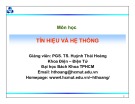
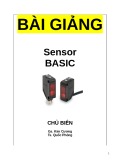

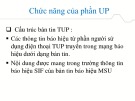
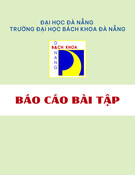
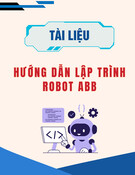




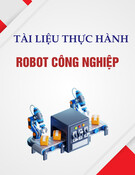




![Bài giảng Kỹ thuật robot [Mới nhất]](https://cdn.tailieu.vn/images/document/thumbnail/2025/20250715/vijiraiya/135x160/366_bai-giang-ky-thuat-robot.jpg)
![Câu hỏi ôn tập Cơ sở xử lý ảnh số [năm] chuẩn nhất](https://cdn.tailieu.vn/images/document/thumbnail/2025/20250710/kimphuong1001/135x160/84701752136985.jpg)

![Câu hỏi ôn tập Robot công nghiệp [năm hiện tại]](https://cdn.tailieu.vn/images/document/thumbnail/2025/20250702/kimphuong555/135x160/7711751422232.jpg)
